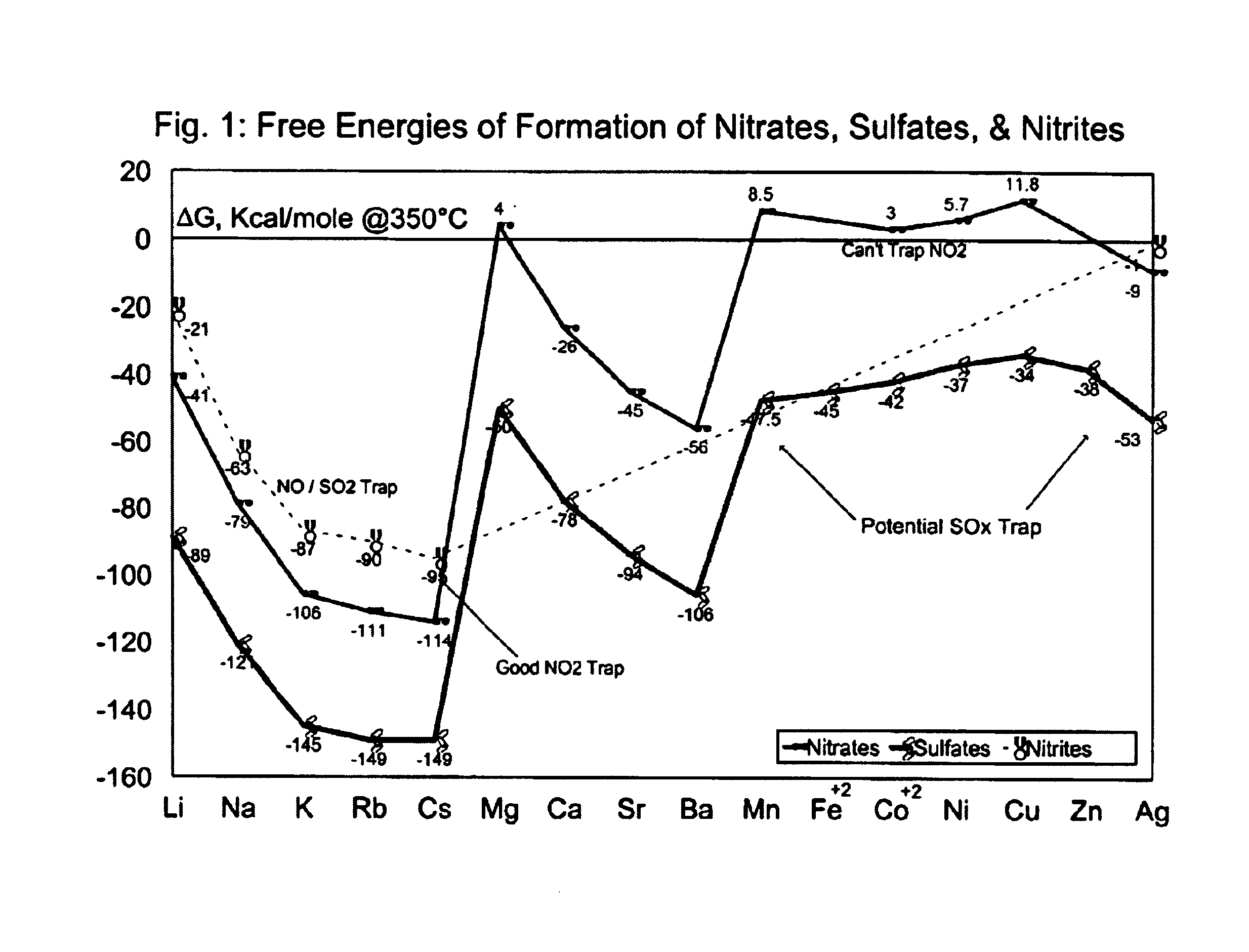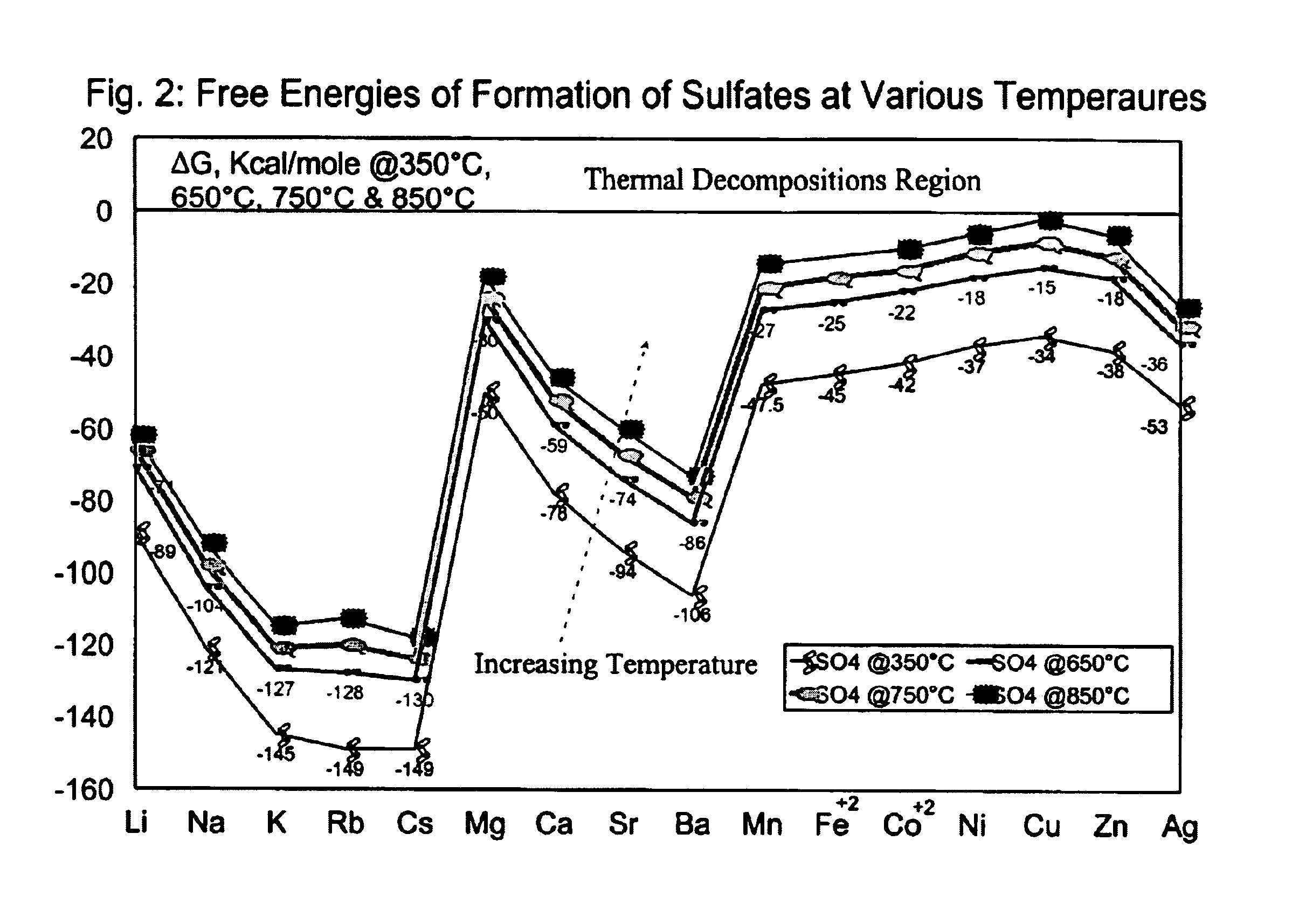Layered SOX tolerant NOX trap catalysts and methods of making and using the same
a sox-tolerant, nox-trap technology, applied in the direction of metal/metal-oxide/metal-hydroxide catalysts, physical/chemical process catalysts, separation processes, etc., can solve the problems of low sox tolerance, high fuel penalty, and particular problem of twc catalysts employing no/sub>x storage components, etc., to achieve low sox tolerance, maintain long-term activity, and reduce sulfur oxide poisoning
- Summary
- Abstract
- Description
- Claims
- Application Information
AI Technical Summary
Benefits of technology
Problems solved by technology
Method used
Image
Examples
example 1
[0251]These examples illustrates the preparation of a layered catalyst composite in accord with the present invention. A layered catalyst composite designated LEX-118 was prepared having the composition set out below.
L-118 First (Bottom) Layer:
[0252]In a planetary mixer, 44 parts of gamma-alumina was impregnated with 0.83 parts of Pt. Pt was introduced as conventional Pt aqueous solution with the dilution to reach incipient wetness of alumina. After drying the Pt-impregnated alumina (Pt—Al) at 120° C. for min. 2 hrs, 1.85 parts of Pd was added in the form of Pd aqueous solution with the dilution to reach incipient wetness of Pt-alumina. The Pd / Pt containing alumina powder was combined with 14 parts of Ba(OH)2, sufficient DI-water, and 2% of acetic acid to make a slurry of 27% solid content before proceeding to milling. The milling was conducted until the particle size distribution showed 90% of particles become less than 10 um. All calculations were based on metal oxide basis except...
example 2
(M-118)
M-118 First (Bottom) Layer:
[0255]In a planetary mixer, 43.1 parts of gamma-alumina was impregnated with 0.82 parts of Pt. Pt was introduced as conventional Pt aqueous solution with the dilution to reach incipient wetness of alumina. After drying the Pt-impregnated alumina (Pt—Al) at 120° C. for 2 hrs, 1.81 parts of Pd was added in the form of Pd aqueous solution with the dilution to reach incipient wetness of Pt-alumina. The Pd / Pt containing alumina powder was combined with DI-water and 2% of acetic acid to make a slurry of 30% solid content before proceeding to milling. The milling was conducted until the particle size distribution showed 90% of particles become less than 10 um.
[0256]The milled slurry have the following materials added: 5.9 parts of Ba(OAc) 2, 13.7 parts of Ba(OH) 2, 9.8 parts of Mn(OAc) 2, 22.7 parts of composite of La / Ce oxide=3 / 7, and 1.96 parts of ZrO(OAc) 2, and sufficiently shear mixed. Additional milling of 10 minutes was exercised to promote better m...
example 3
(M-531)
M-531 First (Undercoat) Layer:
[0258]In a planetary mixer, 31.4 parts of gamma-alumina was impregnated with 0.6 parts of Pt. Pt was introduced as conventional Pt aqueous solution with the dilution to reach incipient wetness of alumina. After drying the Pt-impregnated alumina (Pt—Al) at 120° C. for min. 2 hrs, 1.32 parts of Pd was added in the form of Pd aqueous solution with the dilution to reach incipient wetness of Pt-alumina. The Pd / Pt containing alumina powder was combined with 3.8 parts of Ba(OAc)2 and with sufficient DI-water, and 2% of acetic acid to make a slurry of approximately 39% solid content before proceeding to milling. The milling was conducted until the particle size distribution showed 90% of particles become less than 13 um.
[0259]After milling, 31.4 parts of a Ce / K=7 / 3 solid component, a 31.4 parts of Ce / Cs=7 / 3 solid component were added to the slurry. The slurry was sufficiently shear mixed and milled again until the particle size distribution showed 90% of...
PUM
| Property | Measurement | Unit |
|---|---|---|
| surface area | aaaaa | aaaaa |
| temperatures | aaaaa | aaaaa |
| temperature | aaaaa | aaaaa |
Abstract
Description
Claims
Application Information
 Login to View More
Login to View More - R&D
- Intellectual Property
- Life Sciences
- Materials
- Tech Scout
- Unparalleled Data Quality
- Higher Quality Content
- 60% Fewer Hallucinations
Browse by: Latest US Patents, China's latest patents, Technical Efficacy Thesaurus, Application Domain, Technology Topic, Popular Technical Reports.
© 2025 PatSnap. All rights reserved.Legal|Privacy policy|Modern Slavery Act Transparency Statement|Sitemap|About US| Contact US: help@patsnap.com



